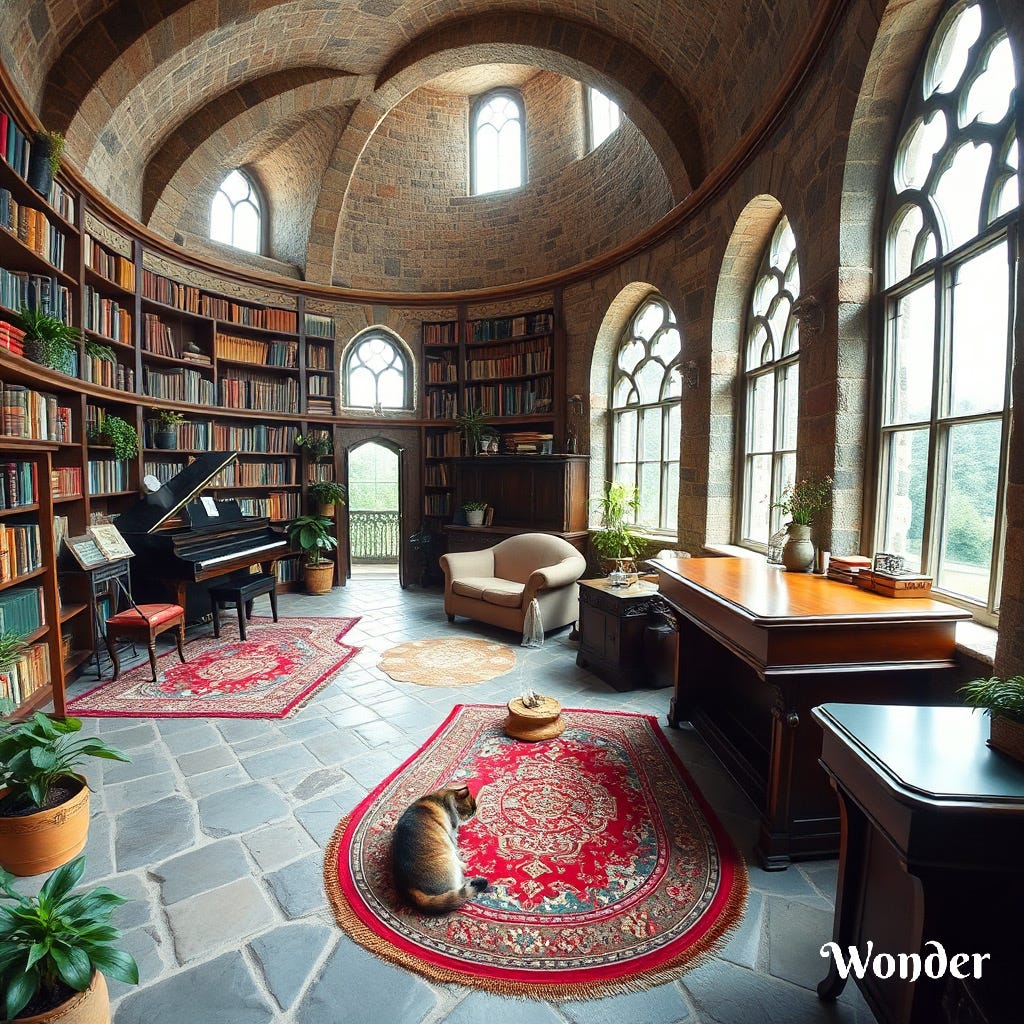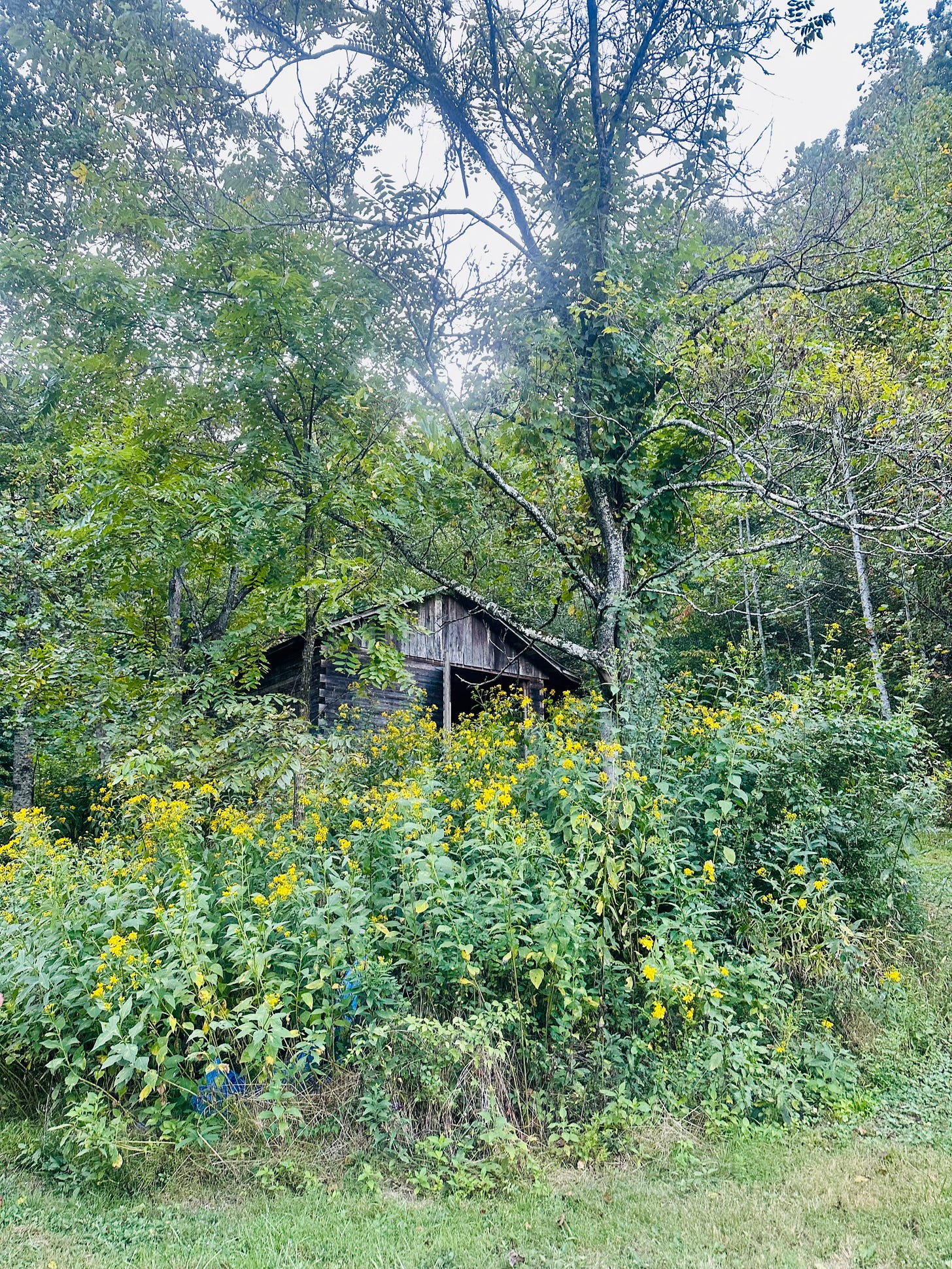“In every heart there is a room / a sanctuary safe and strong”
— Billy Joel, “And So It Goes”
In my previous essay in this series, “Cultivating an Inner Observer,” I wrote about the important practice of noticing your experience, to “level up” to greater perspective, intelligence, and calm.
Building on that skill of observing yourself, this second essay is about establishing a home base of security and connection inside yourself—an inner sanctuary.
Contents:
I. Inner sanctuary: impermeable security
A. Attachment inside, not outside
B. "Where the juice is"
II. Suggestions for creating an inner sanctuary
A. It starts with self-kindness
B. Look for mind-food
C. Visualize your inner world
III. Connections: inner sanctuary in literature
IV. Conclusion: Where I'll Find True SafetyI. Inner sanctuary: impermeable security
I’m most at peace when I’m most connected to myself and my inner life. It’s like there’s a buffer between me and the world. It’s a sense that whatever is happening in my outer world, the place where I truly belong is inside me—and no person or situation I face can take that peace away.
That is what I want to keep practicing and cultivating more, and what I want to write about, in case it can help others, too.
A. Attachment inside, not outside
Another way to describe it is attaching to your inner life, instead of your outer life.
I’m prone to stress and discouragement when I’m attaching my sense of wellbeing to the external contents of my life, such as relationships and situations.
I thrive most when I remember that those outer things are not where my true meaning and security come from. Only attaching to myself—being my own ally and witness, keeping company with myself through whatever happens, and filling up my mind with what I choose—can give me a source of wellbeing and meaning that does not depend on external things. This is the impermeable security of inner sanctuary.
Certainly (as in Billy Joel’s staggeringly beautiful song “And So It Goes”), it’s healthy to be able to let some people into our emotional space and form intimate social connections. I want that, too. But I want my deepest, strongest bond to be with myself, the one person I’ll always have.
B. “Where the Juice Is”
People, situations, events, pressures, experiences—all the contents of your daily life—do not have to be all the contents of your mind.
Thinkers from ancient Stoic philosophers to Zen Buddhists have talked about and practiced this in various ways, often using images and metaphors.
Here’s my metaphor: the hard, outer rind of a melon is for protection and defense, not for eating; the inside is where the fruit is. It’s like we’re trying to eat the rind when we expect our sense of inner wellbeing to come through successful management of the outer contents of our lives (such as work, family, groceries, bills, etc.). That’s not where the “juice” is.
Of course, we do need safety—the “juice” can’t exist without the rind’s protection—but the external kind of safety is not where to look for lasting meaning and fulfillment. The juice is on the inside.

II. Suggestions for creating an inner sanctuary
A. It starts with self-kindness
Self-kindness may come easily to some people (though I don’t know them!), and it may look like simply talking to yourself like you would to a friend, with sympathy and encouragement. For example: “You’ve been working hard, Self; and even though it doesn’t always feel like it, you’re doing a good job.”
But for others, it’s not so easy. The thought of that kind of self-friendliness may even bring on mental screams. When children grow up in emotionally scary environments, they internalize the scorn, shaming, and hassling they receive from their caregivers. Then, even as adults, it literally does not feel safe to speak kindly to themselves.
So if your mind feels more like a haunted house than a cozy sanctuary, this is where the work is: gently, gradually noticing your experiences (including your defense mechanisms in action), aiming for interested observation instead of judgment. This practice will serve to turn on some lights in your mind’s haunted house, showing you what’s really there and equipping you to begin clearing out the cobwebs.
Practicing mindfulness (observing yourself) and self-kindness will help make your mind a safer place to be.
B. Look for mind-food
Upon the foundation mindfulness and self-kindness, build a practice of seeking mind-food that nourishes you.
The goal is to give your mind something to think about that you actually want to think about, that you choose on purpose to think about, instead of whatever random or anxiety-fueled thing your brain automatically generates as content for your cognition energy (as mine does, anyway).
What lights up your mind?
For me, the most nourishing kind of mind-food is writing. I love it when, in moments of idleness and/or excess anxiety, I can turn my mind deliberately to a writing project or poem. (This is a main driver behind my “Serenity Splash” poems.)
Learning is my best friend’s preferred mind-food. She’s constantly listening to audiobooks, figuring out new practical skills on her homestead, learning languages through podcasts and Duolingo, and asking ChatGPT questions about all sorts of interesting things.
Meanwhile, my husband is inwardly nourished by hunting, my sister-in-law by decorating, and my sibling by making music.
What excites you and sparks your interest? Look for ways to purposefully reach for it, as much as you can, to nourish your inner life—and to fill your mindspace with content you choose instead of automatic content you don’t.
C. Visualize your inner world
If you like, you can elevate the concept of “inner sanctuary” beyond the merely figurative: you can literally create an imaginary sanctuary for your mind. All you need is your imagination to construct and visualize it. You could even draw a picture of it (or get AI to make you one)!
Making your own inner world
You could start by imagining a room inside your heart that is a safe place for only you. Fill it with things you like, “paint” the walls with your favorite color, make it as big or small as feels comfortable—imagine it however you want, in as much detail as you can.
Then “visit” it often, for maximum benefit—perhaps as a nightly practice before you go to sleep, or when you wake up in the morning, or at some other regular, solitary time that works for you.
About my inner world
I’ve been creating my own imaginary inner world for almost two decades now, starting when I went to a treatment center for severe depression when I was twenty-two. Prompted by some therapist or exercise there (I can’t recall now), I imagined an inner room for myself that was at the top of a tall tower, safe from the rest of the world. I added a big window with a lovely view, a big desk for writing, walls lined with bookshelves, a piano, a cat, a fountain, and a comfy couch.
That was the first creation of my “tower room.” Over the years it has expanded into a castle, then a kingdom, then a whole secret dimension that no one else can access. (There are other “people” in my inner world, but they are all just different versions of me—both made-up characters and my inner versions of actual people in my real life.)
I’ve got meditation gardens, writing rooms, a huge library, a throne room, pools, caves, beaches, forests, and on and on. (I’ve got a song coming about it, actually, that I’ve just been waiting for time to sit down and record—so stay tuned for more on this!)
It’s up to YOU
The key feature of having an inner world is that it’s all up to YOU. You can make it up and change it however and whenever you want. It’s a resource for your own unique mind, made by you.

III. Connections: inner sanctuary in literature
I treasure certain pieces of classic poems and prose passages about this topic. Here are some of my favorites:
Marcus Aurelius (ancient Greek philosopher [Stoic]), in his book Meditations, on the power of having an inner sanctuary:
“For it is in your power whenever you choose to retire into yourself. For there is no retreat that is quieter or freer of trouble than a man’s own soul, especially when he has within him such thoughts that by looking into them he is immediately in perfect tranquility; and tranquility is nothing else than the good ordering of the mind. Constantly then give yourself this retreat, and renew yourself.”
Emily Dickinson (whom I love!) on self-connection as profound and infinite:
There is a solitude of space,
Of sea, of death, but these
Society shall be
Compared with that profounder site—
That polar privacy—
A soul admitted to itself—
Finite infinity.Ralph Waldo Emerson, in his essay “Self-Reliance” (which I love!), on the ability to dwell in one’s inner sanctuary even while in the company of other people:
“It is easy in the world to live after the world’s opinion; it is easy in solitude to live after our own; but the great man is he who in the midst of the crowd keeps with perfect sweetness the independence of solitude.”
Maybe it’s too soon to refer to Taylor Swift’s songs as “classic literature,” but hey, I’m a Swiftie! I was thrilled to hear her sing about having a lush and locked inner world on her album The Tortured Poets Department:
“I hate it here, so I will go to /
Secret gardens in my mind /
People need a key to get to /
The only one is mine”
IV. Conclusion: Where I’ll Find True Safety
For one last connection, here’s one of my own “Serenity Splash” poems that helps me remember to practice looking for my meaning, safety, and wellbeing inside me rather than outside:
🪷“Where I’ll Find True Safety”
Not in managing their feelings,
nor always keeping peace,
nor making sure that everyone
is fully pleased with me—not in mastering conditions,
keeping things under control—
I’ll only find true safety
in alignment with my soul.
💗
Thanks for reading, and please let me know if this resonates with you. What other tips, thoughts, or connections would you add?
I am wishing you the peace of inner sanctuary, in whatever form works best for you.



Great essay! And I respect your commitment, buying a watermelon for the post! I don't know that I've ever had watermelon-ade.
Something I was really struggling with lately--relating to the stuff that came to a head last week--is that I couldn't communicate with my inner observer. And thinking on the fly here, it seems like the inner observer is maybe the gatekeeper of the inner sanctuary? Like if I can't recognize the struggle, I can't reach safety from it? I dunno, that thought clearly hasn't fully developed yet. 😅
I absolutely love the way you share your journey and always give me something to think about. You're so thoughtful and giving with your words! ❤️